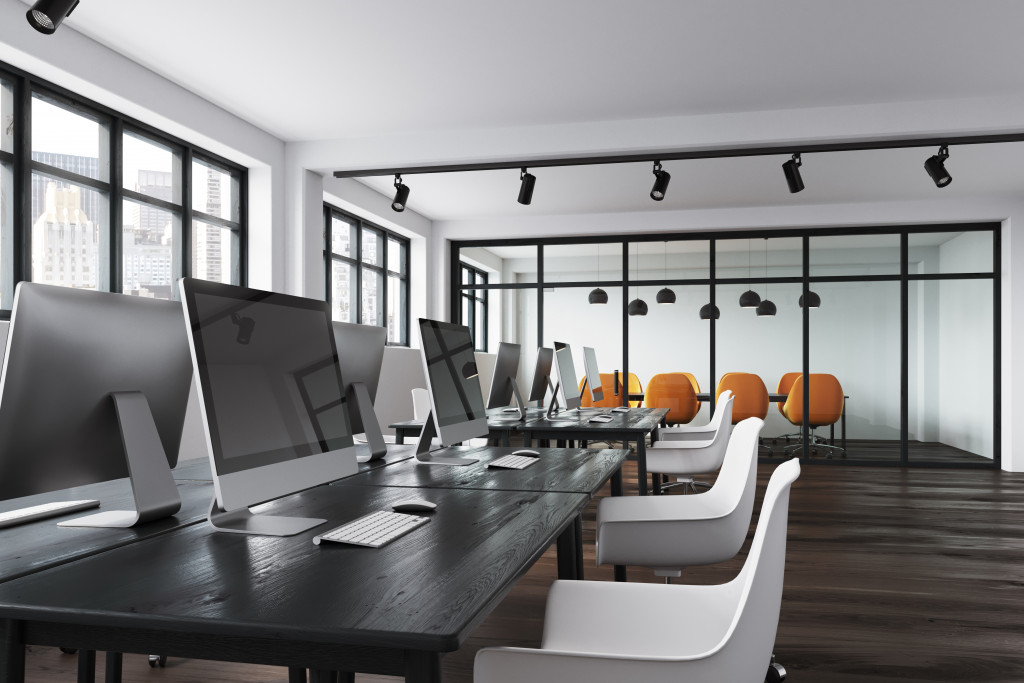- Optimize the layout of furniture to promote comfort, flow, and teamwork.
- Ensure that the essential tools and technologies are available to facilitate tasks and foster collaboration.
- Create a positive atmosphere with elements like artwork, plants, and natural lighting.
- Create efficient organization systems to maintain a clutter-free workspace.
- Prioritize cleanliness and hygiene by outsourcing professional services.
An efficient workspace is vital for the productivity and well-being of your employees. Creating an environment that supports their tasks while fostering comfort and health is a thoughtful approach to business management. Below are five strategies to cultivate an efficient workspace for your team.
1. Optimize the Layout for Productivity
Selecting and arranging furniture efficiently can directly impact employee productivity. Choose ergonomic chairs and desks to provide comfort during long work hours, preventing health issues and boosting concentration. Also, consider the workflow within the office and arrange the furniture accordingly to facilitate smooth movement and communication between different departments.
The layout should also incorporate private spaces for focused work and open areas for collaboration. Balancing the need for concentration and interaction enhances the efficiency and adaptability of the workspace.
2. Invest in Technology and Tools
Equip your employees with the necessary tools and technology to perform their tasks efficiently. Updated computers, high-speed internet, and relevant software applications can expedite work processes, reducing time and effort. Implementing project management and communication tools also improves the coordination and tracking of tasks among team members.
In addition, consider investing in technology that supports remote working. This flexibility allows employees to work from different locations, ensuring continuous productivity despite unforeseen circumstances.
Here are some technologies and tools to implement:
Cloud Computing Solutions
Cloud computing provides a platform for storing and accessing data over the Internet instead of your computer’s hard drive. This technology promotes collaboration among teams and secures data backup, reducing the risk of data loss. Google Cloud and Amazon Web Services are notable examples of cloud computing solutions.
Productivity Apps

Productivity apps like Microsoft Office 365 and Google Workspace offer a range of tools, from document creation to email management. These apps enhance collaboration by allowing multiple people to work on a document simultaneously and provide features for tracking changes and commenting.
Project Management Tools
Project management tools like Asana, Trello, or Jira help teams manage tasks and deadlines more efficiently. They offer features like task assignment, time tracking, and progress visualization, making overseeing project development easier and ensuring timely completion.
Video Conferencing Tools
In the era of remote work, video conferencing tools like Zoom, Microsoft Teams, or Google Meet are crucial. These tools support online meetings, webinars, and virtual collaboration, enabling teams to maintain real-time communication despite geographical boundaries.
3. Create a Positive and Inspiring Atmosphere
A conducive work environment is about physical comfort and creating a positive and inspiring atmosphere. Incorporate elements that uplift the mood and stimulate creativity, such as artwork, plants, and lighting. The color scheme of the workspace should also evoke a sense of calm and focus, with perhaps a few vibrant hues to energize the space.
Ensure that the office is well-lit, preferably with natural light, to reduce eye strain and enhance the overall well-being of your employees. A pleasant view, if available, can also contribute to a more enjoyable workspace.
4. Implement Organization Systems
Efficient organization systems are fundamental for a clutter-free and functional workspace. Introduce filing systems, storage solutions, and policies encouraging employees to maintain order in their respective areas. A tidy workspace facilitates easier access to documents and tools and creates a sense of professionalism and discipline within the team.
Incorporating digital organization tools can also streamline work processes, making managing, sharing, and storing information easier. These tools are especially crucial in a hybrid or fully remote work setting, as they support collaboration and transparency among team members who are not physically present in the office.
5. Maintain Cleanliness and Hygiene

A clean and hygienic office is crucial for the health of your employees, especially in the current global health landscape. Regular cleaning, waste disposal, and sanitization should be non-negotiable aspects of office maintenance. Hiring a professional hygiene services contractor can ensure these tasks are performed to the highest standards, creating a safe and healthy workspace for everyone.
These professionals specialize in providing a range of hygiene services tailored to the needs of corporate environments, from waste management to deep cleaning and sanitization. Outsourcing these services allows your team to focus on their core tasks while experts handle the crucial aspect of workplace hygiene.
In Closing
Maintaining an efficient workspace requires thoughtful planning and continuous effort in various areas, from the physical layout to cleanliness and hygiene practices. By implementing these five tips, you create an environment that supports your employees’ productivity and contributes positively to their job satisfaction and well-being. With a well-designed and maintained workspace, you pave the way for improved performance and success for your business.



